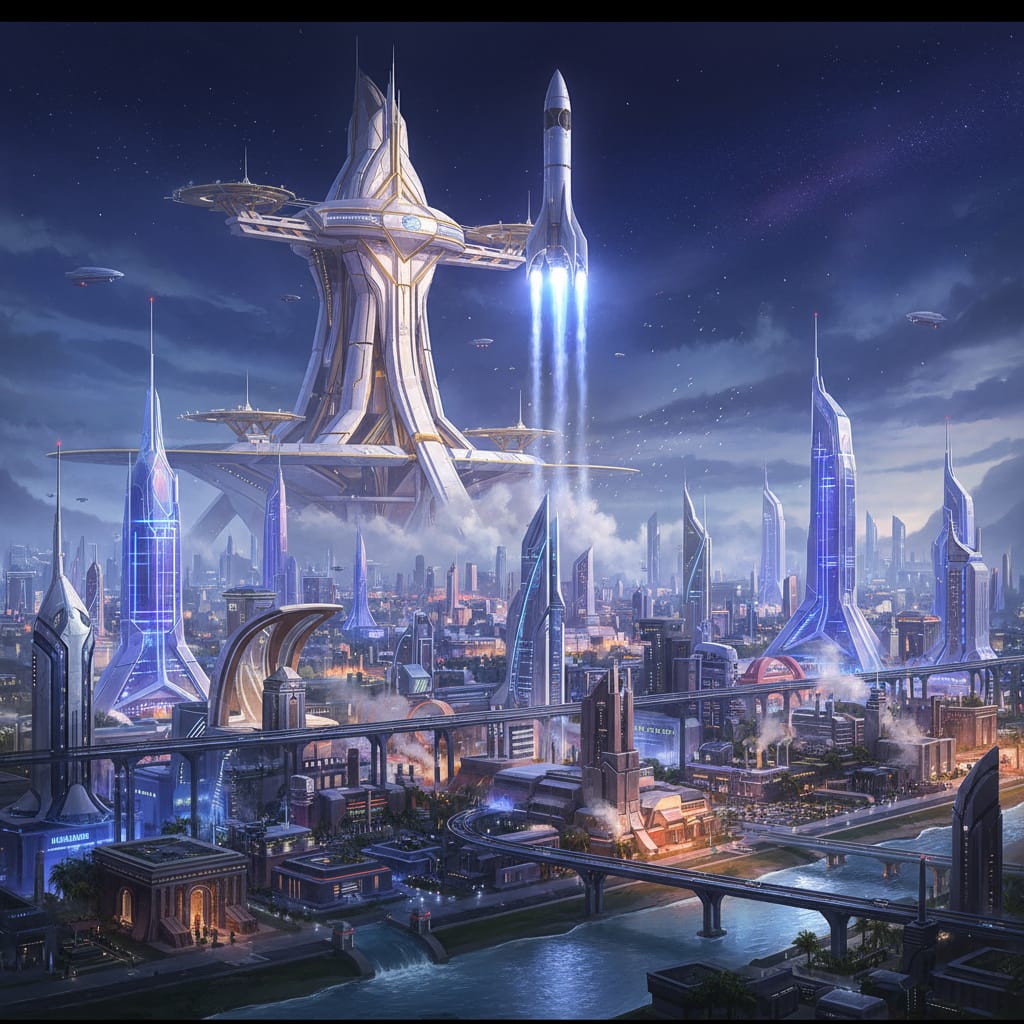A subtle but game-altering change, mandating the construction of the Spaceport exclusively in a civilization’s capital, would send ripples across the entire strategic landscape of Civilization 6. This hypothetical constraint would fundamentally reshape the path to a Science Victory, elevating the capital from a mere administrative center to the single most critical city in the empire. The familiar strategy of identifying a late-game production powerhouse for the Spaceport would become obsolete, replaced by a new paradigm demanding foresight, meticulous planning, and a radical rethinking of early-game priorities. This guide delves into the strategic depths of this scenario, offering a comprehensive analysis of how to navigate this altered path to the stars.
The New Role of the Capital: From Administrative Center to Scientific Hub
Under this new rule, the capital is no longer just the city you start with; it becomes the linchpin of your entire scientific endeavor. Its production capacity, population, and district slots are no longer just important; they are the sole determinants of your success in the space race. This shift in emphasis has profound implications for every stage of the game.
Early Game: The Primacy of Production
The very first decision of the game—where to settle your capital—is now fraught with even greater significance. The ideal starting location must not only offer the standard trifecta of food, production, and fresh water but also possess the long-term potential for explosive industrial growth. Analysis on forums shows that players would need to prioritize settling on or near tiles with high production yields, such as hills, forests, and strategic resources like stone or iron. The allure of a high-food start, while still important for population growth, would be tempered by the absolute necessity of a high-production base.
A popular strategy would be to settle on a plains-hill tile, immediately granting the city a 2-production base. The surrounding area would need to be rich in additional hills and forests, not just for immediate yields but for the long-term potential of mines and lumber mills. The presence of a river would be non-negotiable, not only for the housing bonus but also for the potential of a dam and hydroelectric power in the late game.
Mid-Game: The Industrial Revolution in One City
The mid-game would become a frantic race to transform the capital into an industrial behemoth. Every decision, from the choice of districts to the assignment of governors, would need to be laser-focused on maximizing production. The standard “well-rounded” capital of the base game would be a luxury no longer affordable.
The build order for districts would be radically altered. While the Campus would still be a high priority, the Industrial Zone would become equally, if not more, important. The placement of the Industrial Zone would be a critical decision, with players seeking to maximize adjacency bonuses from aqueducts, dams, and strategic resources. The construction of the factory and power plant would be a watershed moment, turning the capital into a production powerhouse that could churn out wonders and, eventually, the components of the spaceship.
Early Game Decisions: Setting the Foundation for a Capital-Centric Science Victory
The early game is no longer a period of gentle expansion and exploration; it is a calculated and deliberate effort to lay the groundwork for a capital-centric science victory. Every choice, from the first civic to the first builder, must be made with the end goal in mind.
The First 50 Turns: A New Set of Priorities
The initial turns of the game would be a delicate balancing act. While the need for early expansion remains, the development of the capital would take precedence. The first builder would not be tasked with creating farms for population growth but with improving production tiles. Chopping down forests to rush-build an early wonder or a critical district in the capital would become a common and often necessary tactic.
The choice of early technologies and civics would also reflect this new reality. While Writing would still be a high priority for the Campus, technologies that unlock production-boosting improvements, such as Mining and Masonry, would be equally important. The early civic tree would be navigated with an eye toward unlocking policies that boost production, such as Agoge and Craftsmanship.
The Role of Governors: Magnus and Pingala Take Center Stage
The choice of governors would be a critical one, with two governors, in particular, rising to prominence. Magnus, with his ability to boost production from chopping and his promotion that allows for the training of settlers without population loss, would be an invaluable asset in the early game. He would allow players to expand their empire without sacrificing the growth of their all-important capital.
Pingala, with his ability to boost science and culture, would be the ideal governor for the mid to late game. Once the capital’s production is secured, Pingala would be assigned to the city to accelerate the research of the late-game technologies required for the space race. His “Grants” promotion, which provides a significant boost to science output, would be a game-changer.
Mid-Game Pivot: Production, Production, Production
The mid-game is where the true challenge of this new scenario begins. The player must resist the temptation to spread their production too thin and instead focus all their efforts on turning their capital into a city that can single-handedly win the space race.
The Industrial Zone and Its Supporting Cast
The Industrial Zone would be the heart of the capital’s production engine. Its placement would be a matter of intense scrutiny, with players seeking to maximize its adjacency bonuses. The construction of the factory and power plant would be a top priority, as would the construction of the supporting districts that boost production, such as the Encampment and the Harbor.
The choice of power plant would also be a critical decision. While the coal power plant provides a significant production bonus, it also has a negative impact on the environment. The player would need to weigh the short-term benefits of the coal power plant against the long-term consequences of climate change.
The Art of the Internal Trade Route
Internal trade routes would become a vital tool for funneling production into the capital. Every city in the empire would be tasked with sending trade routes to the capital, providing it with a steady stream of food and production. This would allow the capital to grow its population and build its infrastructure at an accelerated rate.
The choice of trade route policies would also be important. Policies that boost the yields of internal trade routes would be a high priority, as would policies that increase the number of available trade routes.
The Space Race: Optimizing the Final Frontier
The late game is a race against time. The player must use their capital’s immense production capacity to complete the space race projects before their rivals can achieve another victory condition.
The Spaceport and Its Projects
The construction of the Spaceport would be the culmination of all the player’s efforts. It would be a massive undertaking, requiring a significant investment of production. Once the Spaceport is complete, the player would need to churn out the space race projects at a rapid pace.
The order in which the projects are completed would be a critical decision. The player would need to balance the need to unlock new technologies with the need to complete the projects as quickly as possible.
The Role of Great People
Great People would be a vital asset in the space race. Great Engineers, with their ability to rush the production of wonders and space race projects, would be particularly valuable. Great Scientists, with their ability to provide a significant boost to research, would also be a high priority.
The player would need to actively seek out and recruit these Great People, using their faith, gold, and production to secure their services.
Counter-Strategies: Exploiting the Centralized Approach
This new scenario would not only change the way players approach a science victory but also the way they counter it. A player who is pursuing a science victory under this new rule would be a tempting target for their rivals.
The All-or-Nothing Gamble
A player who is all-in on a capital-centric science victory would be vulnerable to a well-timed military attack. The capture of their capital would not only cripple their production but also end their hopes of a science victory.
A player who is facing a rival who is pursuing a science victory would need to be vigilant. They would need to scout their rival’s capital, looking for signs of a massive production buildup. If they see a player who is neglecting their military in favor of production, they would need to strike quickly and decisively.
The Power of Espionage
Espionage would also be a powerful tool for countering a science victory. A well-placed spy could sabotage a rival’s Industrial Zone, disrupt their rocketry, or even steal their technology.
A player who is pursuing a science victory would need to be on their guard against espionage. They would need to build a network of counter-spies and use their own spies to disrupt the plans of their rivals.
In conclusion, the seemingly minor change of restricting the Spaceport to the capital would have a profound and far-reaching impact on the strategic landscape of Civilization 6. It would transform the science victory from a race of production to a race of foresight, planning, and meticulous execution. The player who can master this new paradigm will be the one who reaches the stars.


